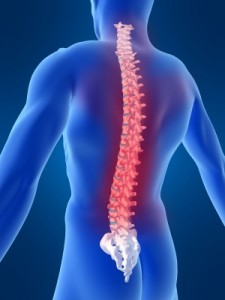 Most of my clients have some kind of spinal dysfunction or pain, whether it be neck pain, back pain, or abnormal posture. Here is an abridged lesson about the spine including a few facts about anatomy, risk factors for pain, and how to preserve and maintain spinal joint health.
Most of my clients have some kind of spinal dysfunction or pain, whether it be neck pain, back pain, or abnormal posture. Here is an abridged lesson about the spine including a few facts about anatomy, risk factors for pain, and how to preserve and maintain spinal joint health.
In most people, the spine is made up of 24 bones, called vertebrae, which are categorized by region. The cervical spine (your neck) has 7 vertebrae. The thoracic spine (upper back) has 12 vertebrae. The lumbar spine (lower back) has 5 vertebrae, which are the thickest and widest, because they have to handle the most load. The lumbar spine connects to the sacrum (your tailbone), which sits in the middle of your pelvis. Your pelvis then connects to your femur (thigh) which connects to your tibia and fibula (shin), which connects to your talus (crux of ankle)…. ok I’ll stop here. The point is bones are sequentially connected up from the foot to the spine. Yes! The position of your foot can affect the posture and position of your spine. That’s crazy! But true, and the reason why there are so many ads for shoe inserts that claim to reduce back pain.
The spine’s number one job is to protect the spinal cord, which transmits messages back and forth from the body to the brain via nerves. Nerves transmit messages about pain, sensation, and your position in space back to the brain. They also transmit information from the brain to the muscles in your body to move and react. Certain spinal conditions can irritate and damage nerves as they exit the spinal column. When nerves are damaged they can get very cranky, causing altered sensation (numbness, tingling), loss of agility and reactivity (clumsiness), or weakness (cramping with everyday activities). This equals pain, sometimes in the butt.
The spine is a stable anchor from which your arms and legs can move. It is the core of your body and thus the active support system is often called the “core muscles.” The spine is also supported by ligaments and the intervertebral discs (referred to only as “discs” if you are in the know). Discs are cartilaginous structures that separate vertebrae, acting as spinal shock absorbers. They are largest in the morning and lose height over the course of the day, which is why we are taller in the morning (hope this fact helps you on Jeopardy). Just as shocks can blow out in a car, so can the discs in your back, leading to very cranky nerves. As we age our discs lose the ability to stay as hydrated, thus they lose height and the spaces between the vertebrae diminish, placing us at increased risk for developing arthritis or nerve irritation. Luckily, you know a good therapist ::wink wink:: who can help you prevent blown shocks and cranky nerves by providing you information about risk factors and tips for maintaining spine health.
Risk Factors for Back Pain
- Poor posture
- Improper body mechanics
- Repetitive movements and stationary positioning
- Age
- Lack of exercise and weakness
- Being overweight
- Tension and stress
- Smoking
- Previous back injuries
- Physical anomalies from birth

Lucky for him, he's an invertebrate.
Top Ten Tips for Maintaining your Spinal Health
- Stay active! 30 minutes of moderate intensity activity is recommended on most days of the week. If you use the “talk test” moderate intensity is hard enough so you feel like you’re working, but not so hard that you can’t talk to someone next to you.
- Exercise, especially core muscles. Stay flexible and strong, particularly in your legs, hips, and shoulders.
- Keep a healthy weight to minimize load on the spine.
- Use proper lifting techniques, avoiding twisting motions.
- Sleep in a position that places the least strain on the spine by keeping a neutral posture. Don’t sleep on your stomach. This position causes your spine to stay extended or bent backwards for a prolonged period of time, placing increased strain on the tiny joints between vertebrae.
- Move frequently and don’t stay in one position for too long. Don’t perform too many repetitive motions, especially twisting and bending.
- Make sure your workspace is ergonomic. Fun ergonomics video
- Stay in good posture. The better your posture, the less stress and strain on the spine.
- Refrain from smoking. Smoking alters bloodflow and limits the body’s ability to heal.
- Just Relax. Stress can increase muscle tone and cause us to fall into faulty postures.
In physical therapy you will learn how to reduce your risk of developing spinal dysfunction or manage the symptoms if you are already experiencing its effects. If you would like more information about the spine and spinal dysfunction you can visit some of the websites below. I am a visual learner and find the pictures of anatomy on these websites to be particularly helpful.
http://www.nlm.nih.gov/medlineplus/ency/article/003025.htm
http://www.nlm.nih.gov/medlineplus/backpain.html
http://www.niams.nih.gov/Health_Info/Back_Pain/default.asp#5
http://www.cdc.gov/niosh/topics/ergonomics/










October 8, 2009
Neurologic, Orthopaedic